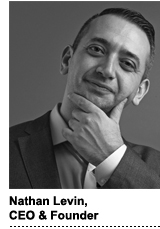Eliminating arbitrage will become even more important after Apple implements its IDFA changes.
Realistically, anywhere from 30% to 80% of a publisher’s traffic is being arbitraged, said Nathan Levin, CEO and founder of Mobile UA Ltd., a one-man consultancy he founded in 2018 to help developers navigate the mobile ecosystem’s complexities and tripwires. His clients include a large banking app and several Fortune 500 companies.
“Going direct to an advertiser gives you a huge advantage, and that will be especially true post-IDFA, because advertisers and developers won’t be able to target high-end users through programmatic channels as easily as before,” Levin said.
The diminished feedback loop will drive down CPMs. But there’s one surefire way publishers can continue capturing that revenue: “Work directly with advertisers so you can continue to get a premium on your traffic.”
Levin spoke with AdExchanger.
AdExchanger: Why did you decide to launch your own consultancy?
NATHAN LEVIN: I used to work on the agency side and for a couple of different ad networks, mainly affiliate marketing, and as I was going along, I realized more and more how much fraud there is associated with mobile and affiliate marketing. And I wanted no part of it.
I moved from one company to another, but it didn’t get much better. Over time, I found that the only way to do this right is to be fully in control of the process of what’s being bought and sold. The C-level and management teams at most companies have no idea what they’re buying and selling. Most agencies have biz dev reps that sell you on the dream and then have no clue what the actual traffic is – and they are completely separate from the day-to-day account managers, the ad ops team and the engineers. It would be great if those teams worked in unison, but they rarely do. There is so much miscommunication.
What is your buying strategy?
My focus is on everything outside of Facebook and [Google] App Campaigns. I’ve found that everyone tends to zero in on the big platforms, and that’s OK. It’s where everyone should start testing. But there is so much inventory out there and ways to monetize efficiency, just not at scale, and so most CMOs want to go by the book and only do what’s proven.
But after personally testing around 300 ad networks, I know which sources are trustworthy and I can pass that knowledge to my clients.
Where are the best places to buy outside of Google and Facebook?
Vendors with direct access to traffic sources and owned-and-operated inventory are best. Or, at the very least, vendors that are able to share exactly which exchanges they’re buying from, otherwise I don’t know what I’m getting. It could just be arbitrage.
And then there are the major publishers you can work with directly country by country. Just go to App Annie and take a look. They’re more than happy to work with you and not have to pay exchange fees.
At any given time, there are usually only between five and 10 apps producing the majority of your revenue. It changes month over month, but as long as you can execute a contract with a publisher fairly quickly, you can be at the top of that waterfall.
What do you think will happen to CPMs when the IDFA eventually becomes permission-based?
Android has already gone up. A lot of people have started to make that shift. They’re scared and they want consistency and measurability, so they’re doing everything they can to stay within their comfort zone.
On iOS, this will cause CPMs to go down, but budgets will slide back as soon as people figure out their baselines.
This is not the apocalypse everyone makes it out to be – as long as you restructure the way you go about your buys. For example, instead of being ROAS-based with definitive targets, you’ll have to rely more on projections and really understand how the monetization works in your own app.
Publishers have a little more time now, but what advice do you have for them to prepare for Apple’s IDFA changes?
If I had any advice for Apple first, it would be to not have only one postback. They’ll be losing out on a lot of money at the end of the day. For example, if you’re HBO and you’re only getting one postback, you can’t tell if you got a trial or if that person actually subscribed. That’s a nightmare for any VOD app or an app that relies on trials, like fitness apps and meditation apps.
To publishers, I’d say just get in there and start testing, don’t hesitate. Get comfortable with how SKAdNetwork works. Don’t panic, test new sources and work out your baselines based on events. Where possible, try and shift your LTV [lifetime value] projections based on the shortest windows possible. Try and figure out exactly where you’re supposed to be at Day Seven for LTV, which is the longest time afforded by the timer in SKAdNetwork.
And start reaching out to advertisers. Find different ways to monetize that you can bank on. I think publishers got too reliant on mediation platforms, and when they see their revenue start to drop significantly, it’s not going to be a fun day.

Source: AdExchanger